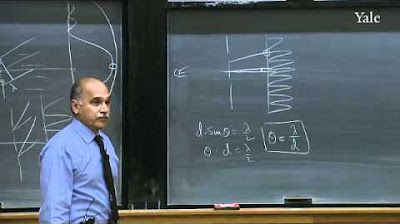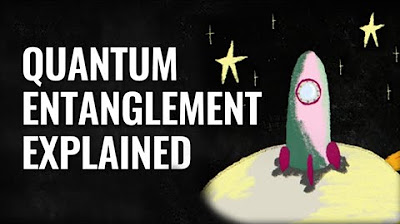The 9 Experiments That Will Change Your View of Light (And Blow Your Mind)
TLDRThis intriguing video explores nine mind-bending physics experiments that challenge our understanding of reality. From the puzzling behavior of light and its wave-particle duality, to quantum entanglement and particles that seem to communicate instantaneously, these thought-provoking experiments erode confidence in the fundamental laws of physics. Ultimately they suggest that at the quantum scale, reality may not obey the normal rules of causality, with information potentially moving backwards in time. Leaving more questions than answers, these experiments underscore how little we truly grasp the underlying strangeness inherent in the universe.
Takeaways
- 😲 Light behaves differently when observed vs when unobserved, interfering with itself like a wave or collapsing like a particle
- 😵💫 Light's speed is not actually constant - experiments show it can go slower or faster than physics predicts
- 🤯 Light takes the path of least time to its destination, even testing improbable routes through time itself
- 😱 Information seems to travel instantly between quantum-entangled particles, defying expectations
- 🫣 The quantum eraser experiment implies light chooses paths based on future detection methods
- 😎 Quantum particles like photons and electrons are driven by probabilities when unmeasured
- 🧐 Measuring one quantum-entangled particle reveals information about the other instantly
- 😮 Bell's theorem experiments show quantum particles create properties spontaneously when measured
- 🤔 The delayed choice experiment suggests particles anticipate future measurement settings
- 😵 Quantum physics allows paradoxical situations like information flowing backwards in time
Q & A
What was the double slit experiment and what did it show about the nature of light?
-The double slit experiment involved shining light through two narrow slits onto a screen. It produced an interference pattern on the screen, demonstrating that light behaves as a wave that interferes with itself.
How did the discovery of the photoelectric effect challenge the idea that light is a wave?
-The photoelectric effect showed that light carried energy in discrete packets called photons. This particle-like behavior contradicted the wave model of light.
What is wave-particle duality and how does the double slit experiment demonstrate it?
-Wave-particle duality means that light exhibits properties of both waves and particles. The double slit experiment shows an interference pattern even when photons pass through one at a time, suggesting individual photons behave as waves.
What is quantum entanglement and how did John Bell's experiment test it?
-Quantum entanglement links particles so measuring one reveals information about the other. Bell's experiment showed entangled particles match correlations that can't be explained by pre-existing properties.
How does the delayed choice experiment seem to show retrocausality?
-Adding or removing a detector after a photon goes through a path still determines whether it interferes with itself as a wave or travels as a particle, as if it knew the future measurement.
What is the three-polarizer paradox?
-With three polarizers, light can pass through all three despite the second blocking the polarization from the first, because photons seem to adopt whatever polarization has the best chance.
How does the concept of quantum spin differ from regular spin?
-Quantum spin refers to how particles interact with magnetic fields, not actual rotation. Spin values can be defined for any direction.
What does the Imperial College time slit experiment demonstrate?
-It shows light can interfere with itself through openings in time, suggesting photons take paths faster and slower than light speed.
Why can't half a wave exist at the quantum level?
-Due to constraints like with harmonics on a guitar string, it seems quantities of energy are restricted to discrete values at tiny scales.
What interpretation might explain strange quantum phenomena?
-That particles exist more as waves of probability without defined values until measured, with space and time not applying, though a full explanation remains elusive.
Outlines
😕 There is much we don't understand about science and nature
This paragraph discusses how there is still much about science and nature that we don't fully understand, using examples like light and sound from a bouncing ball. It talks about how science illuminates much, but there are still areas of darkness and strangeness at the edge of our understanding.
😮 Light behaves differently when observed vs unobserved
This paragraph explores the wave-particle duality of light. It talks about the double slit experiment showing light interferes like a wave, but photons also behave like particles. Most strangely, light seems to behave differently when it's observed vs when it's not, implying it may actually be more like a probability wave that snaps into focus when scrutinized.
😲 Light's speed may not actually be constant
This paragraph discusses experiments where light seems to travel at speeds slower or faster than the universal speed limit, even without dense mediums to explain it. Yet strangely, the light manages to arrive at the expected destination anyway, hinting that it may be testing different probabilistic paths to locate the one closest to maximum speed.
😵💫 A 'double slit' experiment done through time
This paragraph covers an experiment creating 'time slits' by rapidly changing a material from transparent to reflective. Sending laser pulses through these slits creates an interference pattern in frequency rather than position/intensity. Mapping the experiment across time and space implies light taking paths that go backwards/forwards through time to create interference.
😱 Can information travel backwards in time?
This paragraph discusses quantum entanglement experiments (like Bell's theorem) showing information can potentially transmit faster than light or even backwards in time between entangled particles. The 'delayed choice' experiment shows future detector settings somehow retroactively impacting earlier photon behavior through apparent backwards causality.
🤯 Quantum physics is strange
This concluding paragraph admits that quantum physics allows strange phenomena that seem to defy causality and our normal conceptions of space and time. It expresses hope that someday a unifying theory may make sense of it all.
Mindmap
Keywords
💡Light
💡Quantum
💡Entanglement
💡Wavefunction
💡Superposition
💡Observer
💡Retrocausality
💡Interference
💡Phase Velocity
💡Polarization
Highlights
Light behaves differently when you're not looking at it, compared to when you are
Light seems to care about being observed. It behaves differently when interacted with in some way
Light is more like a wave of probability rather than any discrete particle or wave
Experiments suggest that light is lying to us, and call into question the very nature of reality
Light helps us see other things better, but when scientists tried to look at light itself, it was surprisingly difficult
What light appears to be and what light is are actually two different things
Light has proved once again that it doesn’t play by anyone’s rules
Light might be playing a little fast and loose with the linear nature of reality
Experiments suggest that not everything in physics goes through time in the way we might expect
Light always travels the path of least time – the route that allows it to arrive at its destination along the path closest to the universal speed limit
Light is testing the waters – putting out feelers that check to see if other paths, and seemingly other paths through time itself, might present a more viable solution
On the quantum level, time might be obeying different rules
Somehow information had travelled from the one quantum particle to the other in no time at all, far faster than light itself
Experiments suggest that particles somehow saw the future and information was sent back into the past
On the quantum level, maybe space and time simply do not apply
Transcripts
Browse More Related Video

20. Quantum Mechanics II

What If Physics IS NOT Describing Reality?

Why Everything You Thought You Knew About Quantum Physics is Different - with Philip Ball

Quantum Mechanics: Animation explaining quantum physics

Quantum 101 Episode 5: Quantum Entanglement Explained

Best lecture so far on what Entanglement is in Quantum Physics
5.0 / 5 (0 votes)
Thanks for rating: